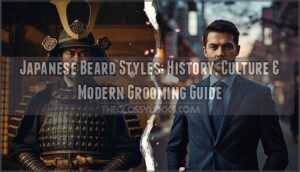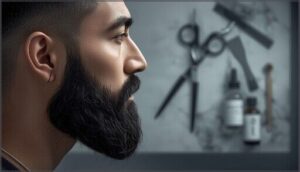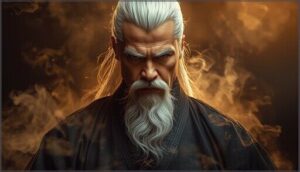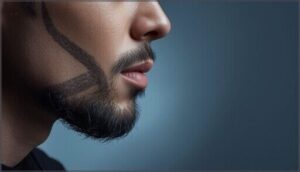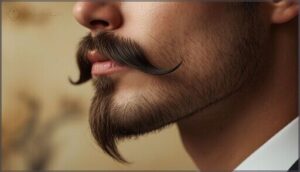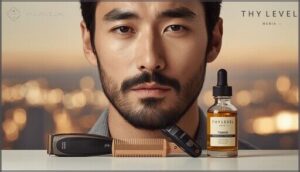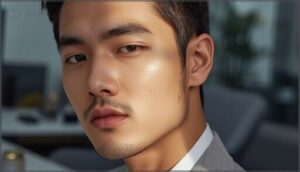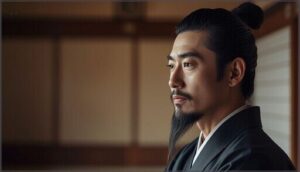This site is supported by our readers. We may earn a commission, at no cost to you, if you purchase through links.
A samurai’s beard once meant he was ready to die in battle. By 1670, that same beard could get him arrested. Fast forward to today, and Japanese beard styles sit at a cultural crossroads—where ancient warrior traditions meet modern grooming trends worth $72 million annually.
The shift didn’t happen overnight. Centuries of bans, Imperial edicts, and Western influence have shaped how facial hair gets worn and perceived in Japan. Yet despite this rich history, 85% of young Japanese women still prefer clean-shaven faces.
If you’re drawn to these styles, you’re not just choosing a look—you’re exploring layers of meaning tied to masculinity, professionalism, and cultural identity. Understanding what works for Japanese facial structures and how to maintain these styles with precision can help you wear them with confidence, whether you’re in Tokyo or anywhere else.
Table Of Contents
- Key Takeaways
- Evolution of Japanese Beard Styles
- Cultural Perceptions of Facial Hair in Japan
- Popular Japanese Beard Styles Today
- Grooming Tips for Japanese Beard Styles
- Beard Styles and Social Impressions
- Frequently Asked Questions (FAQs)
- Did Samurai have facial hair?
- Is facial hair becoming more acceptable in Japan today?
- Is keeping facial hair in Japan considered unprofessional?
- Do Japanese men have to shave off their beards?
- What is the Japanese beard called?
- Can I grow a beard while teaching in Japan?
- Do Japanese barbers specialize in beard trimming?
- Are beards allowed in Japanese job interviews?
- How do Japanese celebrities influence beard trends?
- Conclusion
Key Takeaways
- Japanese beard styles carry centuries of cultural weight—from samurai symbols of courage before 1670 to banned “vulgarity” under Tokugawa rule, then back to acceptance during Emperor Meiji’s Western-influenced revival, creating today’s $72 million grooming market.
- You’ll face real resistance in traditional Japanese workplaces where 70% of companies expect clean-shaven faces, though tech startups and creative industries are slowly opening up to well-maintained facial hair.
- Most Japanese women (85% of those in their 20s-30s) still prefer clean-shaven men, associating beards with untidiness rather than masculinity, which keeps beard prevalence among young Japanese men at just 20-30%.
- If you’re choosing a Japanese beard style, focus on precise grooming and chin-centered designs like goatees or Van Dykes that work with flatter facial structures and often-patchy cheek growth common in East Asian genetics.
Evolution of Japanese Beard Styles
Japanese attitudes toward beards have shifted dramatically over the centuries, shaped by politics, class, and cultural ideals. What started as a badge of warrior pride eventually became a symbol of disorder, then slowly found its way back into modern grooming culture.
Let’s walk through the key turning points that changed how facial hair was viewed in Japan.
Samurai and Historical Beard Traditions
Before the Tokugawa period, samurai wore facial hair as a badge of courage and martial spirit. Medieval warriors paired beards with armor to project ferocity in battle, and the term “hige” symbolized virility across the samurai class. Even leaders like Toyotomi Hideyoshi used artificial moustaches to meet expectations.
Understanding this historical context shows how deeply samurai facial hair shaped Japan’s grooming legacy. However, the later Edo shogunate banned facial hair, citing concerns about public morals.
Tokugawa and Meiji Era Shifts
That tradition collapsed in 1670, when the Tokugawa beard ban made facial hair illegal for most men, transforming samurai beard symbolism from valor to vulgarity. The Meiji Era reversed this completely. After the 1871 Dampatsurei Edict, Emperor Meiji himself grew a beard, sparking a nationwide Meiji beard revival that turned whiskers into symbols of progress:
Japan’s 1670 beard ban turned samurai whiskers from symbols of valor into marks of vulgarity, until Emperor Meiji reversed everything in 1871 and made facial hair fashionable again
- The 1670 “Great Beard Ban” targeted disorder and forced clean-shaven compliance
- Over 95% of officials followed Tokugawa mandates by mid-1700s
- Emperor Meiji’s 1872 bearded portrait normalized Western facial influence
- By 1890, roughly 70% of senior government leaders wore mustaches or beards
Western Influence and Modern Revival
Western influence reshaped Japanese beard styles dramatically after the Meiji opening. By 2024, Western aesthetics drove Japan’s beard product market to $72 million, projected to hit $248 million by 2032.
Media impact through hipster culture and social platforms sparked a cultural shift—workplace norms relaxed in tech sectors, and style revival brought traditional looks like the Van Dyke back with modern twists, making facial hair in modern Japan increasingly acceptable among urban youth.
This growth is fueled by a rising demand for organic grooming products within the Japanese market.
Cultural Perceptions of Facial Hair in Japan
In Japan, facial hair carries meanings that go far beyond personal style. What you grow on your face can shape how people see you at work, in social circles, and even in the dating world.
Let’s look at how Japanese culture views beards and what that means for you today.
Beards and Masculinity
Beards once signaled bravery among samurai warriors, but historical masculinity in Japan has flipped. Today, 85% of Japanese women in their twenties and thirties prefer clean-shaven men, linking beard symbolism to untidiness rather than strength.
Modern perceptions tie masculinity norms to grooming and youthfulness. However, youth trends show a growing acceptance of Japanese beard styles in urban areas and creative industries, challenging traditional cultural norms and gender roles.
Workplace Attitudes Toward Beards
In most Japanese corporations, corporate beard bans remain strict—over 80% of companies in banking, retail, and hospitality enforce clean-shaven grooming standards. Employee discrimination claims have sparked limited policy reform trends since 2020, yet professionalism perceptions still link facial hair to unreliability.
Industry variations exist: tech startups show flexibility, while salarymen in traditional sectors face the toughest workplace culture in Japan around professional appearance.
Changing Trends Among Japanese Youth
Though youth preferences are slowly shifting, beard prevalence among young Japanese men remains remarkably low—only 20% to 30% sport any facial hair. Genetic factors limit full growth for half of men in their twenties, while 85% of women still favor clean-shaven looks. Yet social media and grooming products signal a cultural shift:
- 31% of university students now view beards as more acceptable than their parents did
- Male grooming product sales jumped 15% from 2020 to 2024
- Light stubble experimentation rose 12% thanks to Western media exposure
- Creative industries increasingly embrace facial hair trends in modern society
Despite these changes, most Japanese men with beards remain outside mainstream culture.
Popular Japanese Beard Styles Today
Japanese men today are experimenting with facial hair more than ever before, especially in creative and tech industries. The styles you’ll see range from clean, compact goatees to bold statement beards that balance tradition with modern flair.
Here are the most popular Japanese beard styles you can try or adapt to your own face shape.
Full Japanese Beard
If you’re ready to commit to a full beard, you’re joining a small but growing crowd in Japan. This modern adaptation combines masculine coverage with precise beard grooming—think dense, well-trimmed facial hair paired with a taper fade.
Maintenance routine matters here: regular shaping keeps it sharp, not scruffy. While beard genetics play a role, styling techniques and daily care determine social acceptance. It’s a bold, deliberate choice that demands effort.
Japanese Van Dyke
Want sophistication with sharp angles? The Van Dyke—a mustache paired with a detached goatee—traces back to European influence during Japan’s Westernization. It’s rare here: barbers report only 8% of beard requests are Van Dyke styles, and workplace acceptance sits below 25% outside creative fields.
Media representation remains minimal—fewer than 5% of male characters sport this look—but younger Japanese men in tech and art circles are experimenting. Statistical prevalence is climbing slowly, driven by 14% more online searches since 2022.
Grooming Practices demand precision:
- Shave cheeks and neck twice weekly for clean contrast
- Trim mustache and goatee every 3–5 days
- Use scissors for fine Japanese facial hair texture
- Apply beard oil daily against climate dryness
- Shape with balm for sharp definition
Pai Mei Warrior Look
Ever seen a goatee so dramatic it stops conversations? The Pai Mei Warrior Look—named after Kill Bill‘s white-bearded master—blends martial arts influence with theatrical beard origins.
You’ll spot it at cosplay beard trends events (27% of Tokyo festival styles), rarely in offices. Less than 2% of Japanese men wear it daily, but grooming Pai Mei tutorials are climbing.
Social acceptance remains niche: creative circles celebrate it, traditional workplaces don’t.
Patchy Goatee
Can’t grow a full beard? The Patchy Goatee works with your genetics, not against them. East Asian men often experience sparser cheek growth, making this adaptable Japanese beard style ideal—you’ll concentrate facial hair around the chin and mouth while keeping cheeks clean-shaven.
Cultural attitudes favor neat, controlled grooming practices, so trim regularly and define sharp edges. This social positioning balances personal expression with Japan’s professional expectations.
Long Ducktail Beard
The Long Ducktail Beard channels samurai heritage with Western influence, creating a striking silhouette. This Japanese beard style features an elongated chin point paired with a thin handlebar mustache—think refined warrior meets cosmopolitan style.
Maintenance difficulty runs high here:
- Weekly trimming preserves the symmetrical taper
- Beard oil keeps the 7-12 cm length glossy and smooth
- Clean-shaven cheeks maintain professional boundaries
Only 14-18% of Japanese men can grow facial hair thick enough for this demanding style.
Circle Beard
The circle beard—mustache connected to a rounded goatee—suits fewer than 10% of Japanese beard styles today. Its adoption rate climbed from 3% to 7% between 2012 and 2024, mostly in Tokyo and Osaka.
Workplace policies remain strict, with 44% of service employers discouraging facial hair styles like this.
Grooming expenditure averages ¥3,000 monthly for daily trim routines and beard grooming tips that meet Japan’s cleanliness standards.
Japanese Stubble
Stubble sits at the edge of workplace acceptance in Japan. While nearly 85% of Japanese women aged 20–39 dislike visible stubble—associating it with messiness—younger men in creative fields are experimenting with light five-o’clock shadow.
Japan’s grooming market, projected to hit $24.8 billion by 2030, reflects rising investment in controlled facial hair. Aesthetic preferences still favor clean-shaven faces, though youth trends show subtle shifts toward minimal, well-maintained stubble.
Chinstrap and Chin Beards
Chinstrap and chin beards remain rare in Japan, with only 7% of men wearing them regularly. These defined facial hair styles demand daily upkeep to maintain sharp lines, yet over 70% of traditional companies still discourage them.
Younger Japanese men, especially in creative fields, see modest chin beards as a subtle rebellion against conformity. Cultural associations lean toward “unusual,” though generational acceptance is gradually shifting among urban twenty-somethings experimenting with edge.
Japanese Long Goatee
With roots in samurai tradition, the long goatee remains one of Japan’s rarest beard styles—only 2–4% of men wear it. You’ll find it mostly in artistic circles, where acceptance hits 21% among creatives.
Corporate settings? Still a tough sell at 8% acceptance.
Here’s what makes this Japanese beard style work:
- Pointed chin shaping elongates round or square faces
- Narrow sides (under 15 mm) suit delicate bone structure
- Regular trimming every 7–14 days maintains clean lines
Grooming Tips for Japanese Beard Styles
Getting your Japanese beard style right isn’t just about letting it grow—it’s about shaping, maintaining, and keeping it clean in a way that fits Japanese grooming standards.
Whether you’re working with a goatee, a Van Dyke, or just some light stubble, the same core principles apply. Here’s what you need to know to keep your facial hair looking sharp and culturally appropriate.
Shaping for Japanese Facial Structures
Your facial structure plays a starring role in choosing the right Japanese beard styles. Most Japanese men work with flatter midfaces and softer jawlines, so goatee and chinstrap designs deliver jawline definition that enhances symmetry considerations.
Hair growth patterns—often patchy on the cheeks—make chin-focused facial grooming smarter than full coverage.
Professional shaping at specialty salons helps you match Asian beard styles to your unique face, maximizing product usage for clean, contoured results.
Maintenance and Cleanliness Standards
In Japan, cleanliness isn’t optional—it’s the foundation of acceptable beard care. Corporate policies demand daily washing with sulfate-free cleansers, precise edge trimming, and zero stubble on cheeks or neck.
Hygiene perceptions here run deeper than Western norms; 68% of consumers see facial hair maintenance as requiring extra effort.
Professional grooming tips stress certification standards and product ingredients that support clean, non-irritating beard maintenance routines.
Beard and Eyebrow Coordination
Your beard and eyebrows need to work together—facial symmetry matters. Over 80% of Tokyo professionals say balanced brow shape improves workplace presence, so grooming routines should address both areas.
Match soft, defined eyebrows with trimmed facial hair styles for modern style adaptation. This coordination reflects historical practices from the Heian period, where facial harmony was essential.
Today’s matching hairstyle with beard approach creates a polished, cohesive look.
Recommended Tools and Products
Electric shavers and trimmers are your foundation—Japan’s market hit $318 million in 2024 for a reason. Beard oils, styling waxes, and grooming essentials can be found at specialty stores in Tokyo and Osaka, which hold 32% of the market. Online platforms offer subscription kits and influencer-backed products.
For beard maintenance techniques and facial hair grooming that meet Japan’s cleanliness standards, invest in precision tools and quality conditioning products.
Beard Styles and Social Impressions
Your beard doesn’t just change how you look—it affects how others see you in Japan. From job interviews to first dates, facial hair sends a message before you even speak. Let’s break down how different social settings view beards and what you can expect.
Facial Hair in Professional Settings
Walking into a traditional office with a beard? You’re playing with fire. About 70% of Japanese companies expect salarymen to stay clean-shaven, linking facial hair in the workplace to unprofessionalism.
Corporate beard policies remain strict, especially in retail and finance, where hiring impact is real—38% of interviewers see beards negatively.
However, diversity trends are shifting, particularly in tech startups embracing more relaxed workplace appearance standards.
Beards and Dating Culture
In the dating scene, your beard might cost you matches. Less than 12% of male Tinder profiles show facial hair—69% of Japanese women prefer clean-shaven partners. Dating app preferences lean heavily toward smooth faces, with only 7% positive response to bearded bios on Pairs and Omiai.
Generational acceptance varies slightly, but grooming expectations stay rigid. International dating and gay dating circles show more openness, though.
Acceptance of Beards Among Foreigners in Japan
If you’re a foreigner in Japan, you’re in luck—95% of expat professionals keep their beards without issue. Workplace exemptions are standard in international firms, and social perceptions lean accepting. Tourism thrives without facial hair restrictions, and academic acceptance runs high. Media portrayal even favors bearded foreigners.
While Japanese societal norms remain strict for locals, this cultural taboo rarely touches expat life.
Frequently Asked Questions (FAQs)
Did Samurai have facial hair?
Yes, samurai had facial hair before the 17th century. Samurai beard styles symbolized masculinity and intimidated enemies on battlefields.
However, shogunate beard bans ended this tradition when the Tokugawa period began, making clean-shaven faces mandatory.
Is facial hair becoming more acceptable in Japan today?
Slowly but surely, beards are gaining ground. Youth acceptance, foreign influence, and media portrayal are shifting cultural perceptions of beards.
Modern Japanese grooming trends show workplace shifts, with foreigners with beards in Japan normalizing the rise of facial hair.
Is keeping facial hair in Japan considered unprofessional?
In most traditional Japanese companies, corporate beard bans remain standard. Social stigma persists around facial hair, though international company environments and younger generations show greater acceptance.
Foreign worker acceptance has gradually improved, especially in cosmopolitan settings.
Do Japanese men have to shave off their beards?
There’s no legal shaving requirement in Japanese culture, but workplace beard rules and social stigma create strong pressure.
Most Japanese men stay clean-shaven due to professional expectations and traditional attitudes toward Japanese facial hair regulations.
What is the Japanese beard called?
In Japanese, the word “hige” (髭) refers to all facial hair—mustache, beard, and whiskers. Samurai beards carried historical significance, while the “Fuji style” represents a modern Japanese beard shape.
Can I grow a beard while teaching in Japan?
You can grow a beard style as an ALT if it’s well-trimmed and neat. Employer variability exists—some accept facial hair, others don’t.
Foreigner acceptance is higher, but maintaining cleanliness helps create a good impression among Japanese people.
Do Japanese barbers specialize in beard trimming?
Most barbers in Japan focus on clean shaving rather than specialized beard trimming.
However, urban “neo barber” shops are emerging that offer beard services alongside haircuts, especially for younger clients exploring grooming products.
Are beards allowed in Japanese job interviews?
Traditional companies in Japan still expect you to be clean-shaven for interviews, viewing beards as unprofessional. However, tech businesses and foreign firms are increasingly relaxed about well-groomed facial hair.
How do Japanese celebrities influence beard trends?
Celebrity beard endorsements from icons like Hideo Kojima and Hayao Miyazaki are cutting through centuries of clean-shaven tradition, driving youth grooming choices, market impact, workplace acceptance, and product innovation across modern Japanese beard styles influenced by Western culture.
Conclusion
Your beard choice carries the weight of centuries—each trim echoes decisions made by samurai, reformers, and modern rebels who questioned what masculinity should look like. Japanese beard styles aren’t just grooming decisions. They’re conversations with history, bridges between tradition and self-expression.
Whether you choose stubble or a full beard, you’re shaping more than hair. You’re defining how you want the world to see your confidence, your heritage, and your evolving identity.
- https://japan-dev.com/blog/beards-in-japan
- https://www.reddit.com/r/beards/comments/1cv9x6/amazing_japanese_beard_chart/
- https://en.otokomaeken.com/hair/265680
- https://goldsea.com/article_details/japanese-grooming-dressing-rules-fall-to-labor-shortage
- https://www.fashionbeans.com/article/mens-beard-styles-guide/

